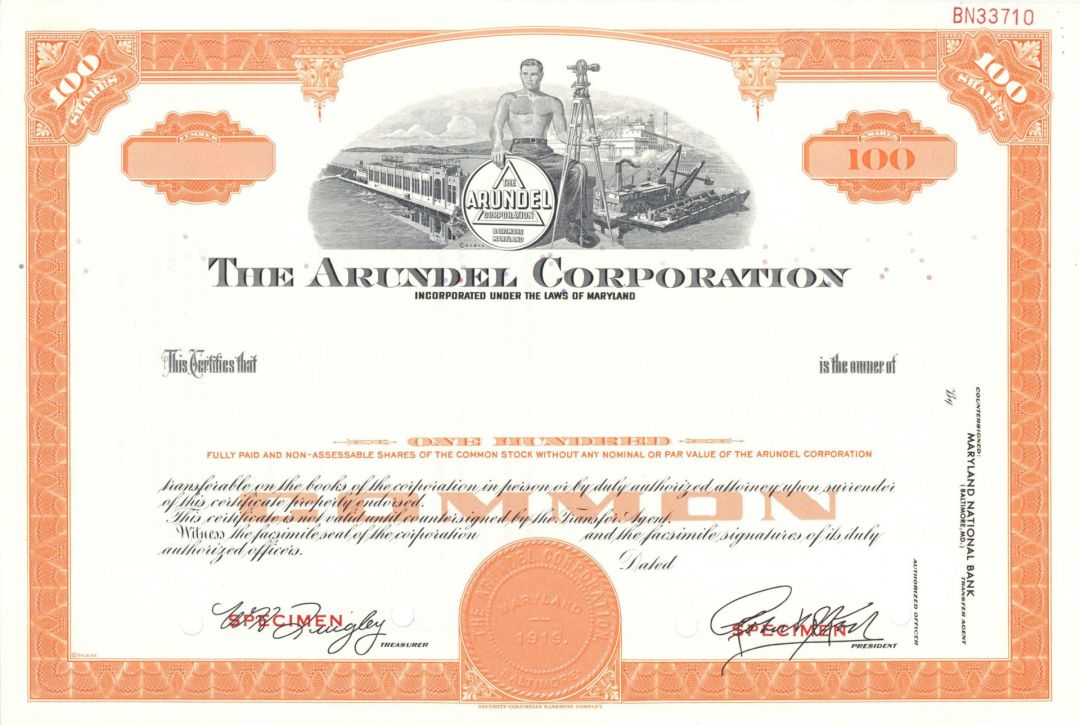Arundel Corp. - 1919 Specimen Stock Certificate
Inv# SE3723 Specimen StockSpecimen Stock printed by Security-Columbian Banknote Company. Please specify color.
The Cambridge Arundel Corporation site is a 15-acre property located adjacent to the harbor at 311 Trenton Street, in the town of Cambridge, Dorchester County, Maryland. The site consists of seven parcels of land, with each parcel varying in size. The largest parcel is approximately six acres and it is at this location where activities related to the manufacturing of fertilizer products were formerly carried out. The Cambridge site was used by Dorchester Fertilizer from 1926 through 1963 to product granulated fertilizer. The facility burned in 1963 and was purchased and rebuilt by the Baugh Company who continued fertilizer production from 1964 to 1965. Kerr-McGee purchased the plant in 1965 and continued fertilizer production until the plant closed in1977. In 1978, the Arundel Corporation purchased the plant and used it for the storage of aggregate for concrete operations. Kerr-McGee, who operated the plant from 1965 to 1977, notified the U.S. Environmental Protection Agency (EPA) that they had disposed of air pollution control sludges on the site in the 1970s. The fertilizer mixing process resulted in dust emissions, which were controlled by scrubbers. Scrubbing effluent was recycled in a closed loop system which utilized two on-site lagoons. The sludge, which settled in the lagoons, was removed periodically and disposed of on an on-site field. At closure of the plant, the lagoons were filled and compacted. As a result of the notification by Kerr-McGee, the site had been placed on the EPA and State of Maryland lists of potential hazardous waste disposal sites. The site is described as receiving 100 tons of inorganic solids. In 1985, a contractor for EPA (NUS) conducted a Site Inspection and preliminary soil sampling which resulted in the detection of lead, pesticides, PCBs and several organic compounds in low concentrations. None of the contaminants observed in the NUS study were determined to be present at levels that presented a threat to human health or the environment. In 1988, the Arundel Corporation completed 41 borings across the site. Composite samples were analyzed for fertilizer components including potassium, magnesium, calcium, nitrate and total phosphorus. Total phosphorus and nitrate values ranged from 733 to 87,000 mg/kg and <1 to 340 mg/kg respectively. In 1989, Environmental Resources Management, Inc. conducted a Phase I Preliminary Investigation of the site. Six shallow borings were collected and a soil gas survey conducted. The investigation concluded that the low levels of base neutral compounds and dieldrin identified did not pose a risk to human health and no further investigation at the site was necessary. In 1992, the Arundel Corporation complied with the Maryland Department of the Environmentâs (MDE) request to address other environmental issues at the site. Among these were the removal and proper disposal of lab chemicals found in a storage room, underground tanks, acid storage tanks and residual acid sludge, two capacitors containing PCBs, transite panels found in structures on site, and stored fertilizer components such as lamp-black, clay and lime. A low level Hazard Ranking Score prompted MDE to recommend the site for no further action. EPA concurred with these recommendations and gave the site a No Further Remedial Action Planned status. The Site Survey Initiative was proposed to reassess the status of those sites that were previously designated No Further Remedial Action Planned by the EPA. This initiative is intended t determine if site conditions have remained stable, provide a current description of the site, and identify and address any new pathways for contamination. The initiative is also intended to enable the State to determine whether the State should recommend further investigation by EPA, oversight by the State and no further investigation by EPA, or no further action taken by EPA or the State and that the State designate the site as a âFormerly Investigated Site.â
Stock and Bond Specimens are made and usually retained by a printer as a record of the contract with a client, generally with manuscript contract notes such as the quantity printed. Specimens are sometimes produced for use by the printing company's sales team as examples of the firms products. These are usually marked "Specimen" and have no serial numbers.










Ebay ID: labarre_galleries